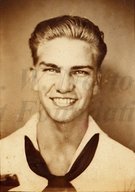
|

|
|
|
|
He was born near Glen Rose, Texas, by a doctor who arrived in a horse and buggy. "Jay," as he was called, joined the U.S. Navy on April 4, 1941 at seventeen. He was sent to Pearl Harbor, arriving on November 20, 1941, as part of a beaching crew for a PBY plane in section VP 23. On December 7, he was in a hanger at the naval air station at 7:30 a.m., ready for duty at 8 a.m. "And then I heard this whaap-boom, he says. "I ran out that door and just as I went a Japanese plane zoomed hanger high and he dropped a bomb on that East Indies airplane." The men jumped in a seven-foot deep trench nearby. "When we'd see a Jap plane (go down) we'd cheer like we were at a football game," he says. Later that day Jay helped launch two PBYs out in the water. "I just stayed around there and would swim around on my back and watched the commotion from out in it," he says of his watery grandstand to America's entry into the war. Jay remained at the air station until after the Battle of Midway. He was returned to the states for a thirty-day leave in December of 1943. He crossed the Pacific again, this time on the George F. Elliott (AP-105) to Espiritu Santos in the New Hebrides. There he changed aircraft engines in Corsairs and PBMs. On VJ Day, he was back in Hawaii at Kaneohe Bay Naval Air Station. Jay was discharged in 1947 in Pensacola as an aviation mechanic's mate, first class. "I'd decided I wasn't going to stay and make a career because they had the GI Bill and I was going to go back and go to college." True to his word, Jay attended the University of Houston. Among other jobs, he worked for Southern Aviation for twenty-three years, and then opened Aviation Machine Shop. |


